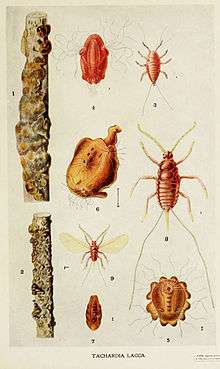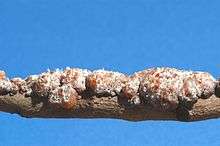Kerria lacca
| Kerria lacca | |
|---|---|
 | |
| Illustration by Harold Maxwell-Lefroy | |
| Scientific classification | |
| Kingdom: | Animalia |
| Phylum: | Arthropoda |
| Class: | Insecta |
| Order: | Hemiptera |
| Suborder: | Sternorrhyncha |
| Superfamily: | Coccoidea |
| Family: | Kerriidae |
| Genus: | Kerria |
| Species: | K. lacca |
| Binomial name | |
| Kerria lacca (Kerr, 1782) | |
| Synonyms | |
| |

Kerria lacca is a species of insect in the family Kerriidae, the lac insects. These are in the superfamily Coccoidea, the scale insects. This species is perhaps the most commercially important lac insect, being a main source of lac, a resin which can be refined into shellac and other products.[1] This insect is native to Asia.[2]
Biology
K. lacca also produces a dye and a wax as natural secretions. The life cycle of this scale insect proceeds with the first instar of the larval stages, which are known as "crawlers". Larvae in this stage crawl along the branches of their host plants and feed on the phloem. As they pierce the branches to reach the phloem, they cover the holes with their wax secretions.[3] This species is also one of several similar insects used to produce a strong red dye historically used to color wool and silk.[4] The dye originates in the hemolymph of the insect; the fluid analogous to blood.[5]
More than 400 host plants have been noted.[2] Three are used for the majority of commercial cultivation of the insect: palas (Butea monosperma), kusum (Schleichera oleosa), and ber (Ziziphus mauritiana).[3]
There are at least two strains of the insect that are characterized by aspects of their life cycle and their host plant preferences.[5]
Ecology
Natural enemies of this species include several parasitoids, such as the parasitoid wasps Tachardiaephagus tachardiae and Coccophagus tschirchii. Predators include the moths Eublemma roseonivia and Holcocera pulverea. These moths can interfere with lac cultivation in India.[6]
These insects, as well as many types of fungal pathogens, form an ecological web that is important to local biodiversity.[5]
K. lacca has been reported as a pest insect. It is reared on ber trees (Ziziphus mauritania), but these trees are also cultivated for fruit, the Indian jujube. K. lacca sometimes invades Indian jujube orchards and degrades the fruit crop.[7]
Economy
Millions of people are engaged in the farming of lac insects.[5] At least half of lac production occurs in India, where about 20,000 metric tons of raw lac are produced annually. It is a versatile product used in a wide array of applications, and demand for it in many industries provides economic resources that filter down to rural tribes.[5] In Vietnam, the introduction of K. lacca cultivation has brought economic recovery to impoverished mountain villages and has helped to revegetate deforested hillsides.[8][9] Demand, while still strong, is shrinking over time, reducing the economic viability of lac growing.[5]
While K. lacca is the most commonly cultivated species in many areas, the related Kerria yunnanensis is the most widely used species in China.[10]
References
| Wikimedia Commons has media related to Kerria lacca. |
- ↑ Raman, A. (2014). Discovery of Kerria lacca (Insecta: Hemiptera: Coccoidea), the lac insect, in India in the late 18th century. Current Science 106(6), 886.
- 1 2 Ahmad, A., et al. (2012). Mouthparts and stylet penetration of the lac insect Kerria lacca (Kerr) (Hemiptera: Tachardiidae). Arthropod Structure & Development 41, 435-441.
- 1 2 Mohanta, J., Dey, D. G., and Mohanty, N. (2014). Studies on lac insect (Kerria lacca) for conservation of biodiversity in Similipal Biosphere Reserve, Odisha, India. Journal of Entomology and Zoology Studies 2(1) 1-5.
- ↑ Wouters, J. and Verhecken, A. (1989). The coccid insect dyes: hplc and computerized diode-array analysis of dyed yarns. Studies in Conservation 34(4), 189-200.
- 1 2 3 4 5 6 Sharma, K. K., Jaiswal, A. K., and Kumar, K. K. (2006). Role of lac culture in biodiversity conservation: issues at stake and conservation strategy. Current Science 91(7) 894-98.
- ↑ Pemberton, R. W., et al. (2006). Host acceptance trials of Kerria lacca (Kerriidae) parasitoids from northern Thailand on the pest lobate lac scale (Paratachardina lobata) (Kerriidae). Florida Entomologist 89(3), 336-339.
- ↑ Lakra, R. K. and Kher, S. (1990). Effect of incidence of lac insect, Kerria lacca (Kerr) on bearing and quality of jujube fruits in Haryana. Indian Journal of Plant Protection 18(1), 125-127.
- ↑ New rural development in Huoi Leng commune, Điện Biên Province. Vov World Service. December 5, 2013.
- ↑ More than 900 ethnic minority households in Mường Lát District escape from poverty. Press Release: United Nations Development Programme, Vietnam. June 27, 1014.
- ↑ Chen, Y., et al. (2014). Multiple ant species tending lac insect Kerria yunnanensis (Hemiptera: Kerriidae) provide asymmetric protection against parasitoids. PloS One 9(6), e98975.